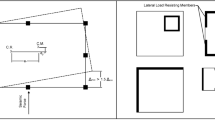Abstract
General regular shaped diagrid structures can express diverse shapes because braces are installed along the exterior faces of the structures and the structures have no columns. However, since irregular shaped structures have diverse variables, studies to assess behaviors resulting from various variables are continuously required to supplement the imperfections related to such variables. In the present study, materials elastic modulus and yield strength were selected as variables for strength that would be applied to diagrid structural systems in the form of Twisters among the irregular shaped buildings classified by Vollers and that affect the structural design of these structural systems. The purpose of this study is to conduct sensitivity analysis for axial rotation diagrid structural systems according to changes in brace angles in order to identify the design variables that have relatively larger effects and the tendencies of the sensitivity of the structures according to changes in brace angles and axial rotation angles.
Similar content being viewed by others
References
Ahn KW, Yang JK and Park SS (2015), “Sensitivity Analysis on the Lateral Behavior of Diagrid Structure,” Journal of The Korea Institute for Structural Maintenance and Inspection, 19(3).
KBC2009 (2009), Architectural Institute of Korea, Korean Building Code, South Korea.
Kim JK, Lee YH (2009), “Seismic Performance Evaluation of Diagrid System Buildings,” Journal of the Architectural Institute of Korea Structure & Construction, 25(6).
Kim JR, Kim SB, Park YH and Jung WG (2000), “A Statistical Study on the Mechanical Properties and Chemical Components of Rolled Steels for General Structure, SS400,” Proceeding of Architectural Institute of Korea, 20(1): 229–232.
Kim JR, Kim SB, Park YH and Jung WG (2000), “A Statistical Study on the Mechanical Properties and Chemical Components of Rolled Steels for Welded Structure, SM490.” Journal of Architectural Institute of Korea, 16(11): 3–10.
Lee TH and Mosalam KM (2009), “Identifying Significant Components of Structures for Seismic Performance Using FOSM Method,” Earthquake Engineering Society of Korea, 13(4).
Moon KS (2007), “Diagrid Structural Systems for Tall Buildings: Characteristics and Methodology for Preliminary Design.” The Structural Design of Tall and Special Buildings, 16: 205–230.
Porter KA, Beck JL, and Shaikhutdinov RV (2002), “Sensitivity of building loss estimates to major uncertain variables,” Earthquake Spectra, 18(4): 719–743.
Vollers K (2008), “Morphological scheme of secondgeneration non-orthogonal high-rises,” CTBUH.
Author information
Authors and Affiliations
Corresponding author
Rights and permissions
About this article
Cite this article
Yang, JK., Li, LY. & Park, SS. Sensitivity analysis for axis rotation diagrid structural systems according to brace angle changes. Earthq. Eng. Eng. Vib. 16, 783–791 (2017). https://doi.org/10.1007/s11803-017-0414-9
Received:
Accepted:
Published:
Issue Date:
DOI: https://doi.org/10.1007/s11803-017-0414-9




